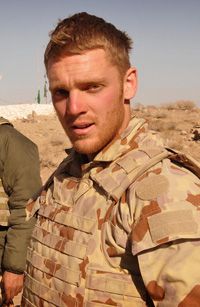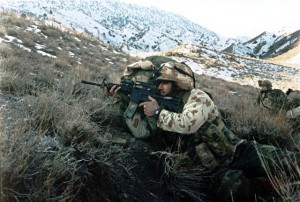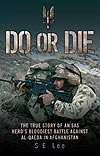The Australian Army has released a new report on the fatal wounding of Corporal Mathew Hopkins who was Killed In Action on March 16 while on patrol in Afghanistan.
The Inquiry Officer found that the gunshot wound from Taliban insurgents was fatal and that “no medical intervention would have saved him”.
Corporal Hopkins was 21, married and a father.
An Army press release distributed earlier today said Hopkins was the first member of Australia’s Mentoring and Reconstruction Task Force to be killed since it was created last October. Eleven Australian soldiers have been killed in action in Afghanistan since 2001.
The Army’s 2IC, Lieutenant General David Hurley said that Hopkins’s fellow troops performed brilliantly while under heavy fire north of Tarin Kowt in providing medical assistance to their mate while evacuating him. They relied on their training and followed procedures, and they were also blessed by a bit of luck.
It was chaotic, LtGen Hurley said, which would be under-selling the nightmarish details of the attack.
Having spent months and months with a former trooper from the Special Air Service Regiment I have some idea of the chaos, terror and fear that our troops experience on the battlefield in modern warfare.
I wrote a book (18 Hours, The True Story of an SAS War Hero) about Signalman Martin ‘Jock’ Wallace who won the Medal for Gallantry for his courage and bravery under fire in Operation Anaconda in 2002.
Anaconda was a joint operation led by the Americans from the 10th Mountain Division and the 101st Airborne Division (Air Assault), otherwise known as The Screaming Eagles. Jock Wallace was attached to the 10th Mountain division to ensure there were no friendly fires between the US troops and the Aussie SAS patrols doing extremely dangerous work out in the valleys and mountains of the Shahi Kot in southern Afghanistan.
The operation, though, was doomed from the start. The intelligence was wrong, and the incoming troops were ambushed by up to 1000 Taliban terrorists who had the higher ground. Jock fought for his life for 18 hours, at one point lying on a live hand grenade with the pin pulled to booby-trap his body and equipment in case he was shot.
He did what Corporal Hopkins’s mates did: showed extraordinary resilience and courage and kept his cool.
Wallace ran into the line of fire several times to rescue wounded Americans, risking his own life to save others. That is the type of action recognised by the prestigious Medal for Gallantry.
The thing that impressed me with Jock was his honesty. I can still hear him saying “any bloke who tells you they aren’t scared when the bullets are flying by and the bombs are raining down is either lying or stupid”. It was, he told me, worse than hell.
Chaos doesn’t begin to describe it. Nor does it begin to describe the horror Corporal Hopkins and his fellow diggers found themselves in.
That they acted with such bravery under fire and kept their cool speaks volumes about their character and training.
The Army’s report into Corporal Hopkins’s death recognises that, as well as properly acknowledging its troopers’ professionalism.
We must not forget them.



